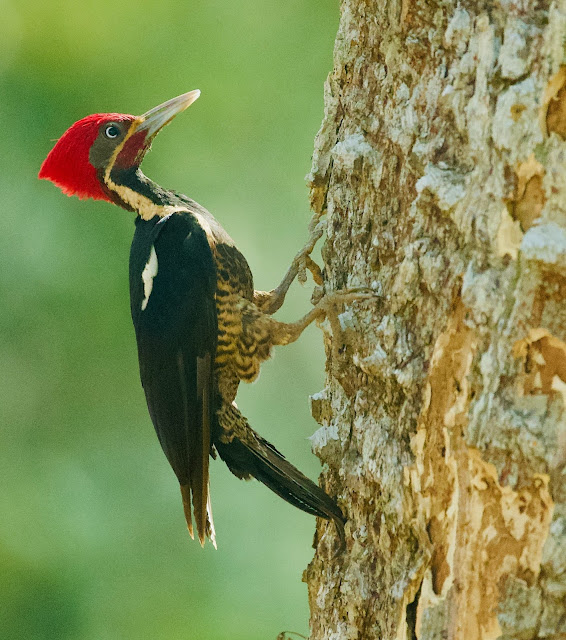Andaman woodpecker
The Andaman Woodpecker (Dryocopus hodgei) is a fascinating bird species found exclusively in the Andaman and Nicobar Islands in the Bay of Bengal, India.
Striking Appearance: The Andaman Woodpecker is a visually captivating bird. It has a predominantly glossy black body with distinct white barring on its wings and underparts. The head is adorned with a striking crimson crest, adding a splash of vibrant color to its overall appearance.
Impressive Size: This woodpecker is known for its relatively large size compared to other woodpecker species. It measures around 30 to 35 centimeters in length, making it a notable and prominent bird.
Distinctive Features: The Andaman Woodpecker has a robust body with a strong, chisel-like bill that is perfectly adapted for pecking and drilling into tree trunks. It has strong feet with sharp claws that enable it to cling to vertical surfaces while foraging for food.
Forest Dweller: The Andaman Woodpecker primarily inhabits dense evergreen forests, making its home among the towering trees of the Andaman Islands. It is highly skilled at climbing, hopping, and maneuvering along tree trunks and branches in search of food.
Foraging Behavior: This woodpecker has a specialized diet consisting of insects, grubs, beetle larvae, and other small invertebrates found beneath the bark of trees. It uses its powerful bill to drill into the wood, creating holes to extract its prey.
Vocalizations: The Andaman Woodpecker communicates through a variety of calls and drumming sounds. Its calls include sharp, high-pitched notes that serve as territorial calls and for maintaining contact with its mate.
Endemic Species: The Andaman Woodpecker is a unique and endemic bird species, meaning it is found exclusively in the Andaman and Nicobar Islands. Its restricted range and specialized habitat make it a prized sighting for birdwatchers and nature enthusiasts.
The Andaman Woodpecker is a remarkable bird with its captivating appearance, powerful foraging capabilities, and status as an endemic species of the Andaman Islands.
History
The Andaman Woodpecker (Dryocopus hodgei) is a bird species that is native to the Andaman and Nicobar Islands in the Bay of Bengal, India. The history of the Andaman Woodpecker is closely tied to the unique ecosystems and geographical isolation of the Andaman Islands.
Endemic to the Andaman Islands: The Andaman Woodpecker is endemic to the Andaman and Nicobar Islands, which means it is found exclusively in this region and nowhere else in the world. The bird has adapted to the specific environmental conditions and resources available on the islands.
Geological Isolation: The Andaman and Nicobar Islands have been geographically isolated for millions of years, separated from mainland India by a deep ocean trench. This isolation has led to the evolution of numerous endemic species, including the Andaman Woodpecker.
Adaptation to Island Habitats: Over time, the Andaman Woodpecker has adapted to the unique forested habitats found on the islands. It has developed specialized skills for climbing trees, excavating wood, and foraging for food within the dense forests.
Conservation Status: The Andaman Woodpecker is classified as a species of "Least Concern" on the IUCN Red List, indicating that it is not currently facing any significant threats to its survival. However, like many other bird species, it may face challenges such as habitat loss due to deforestation or disturbance.
Research and Conservation Efforts: The Andaman Woodpecker, as a unique endemic species, has attracted the attention of researchers and conservationists. Studies on its ecology, behavior, and population dynamics have been conducted to better understand and protect the species and its habitat.
Overall, the Andaman Woodpecker's history is intertwined with the natural history and ecology of the Andaman and Nicobar Islands. Its evolution and adaptation to this isolated island environment highlight the fascinating biodiversity of the region and the importance of conserving its unique species.







0 comments:
Post a Comment